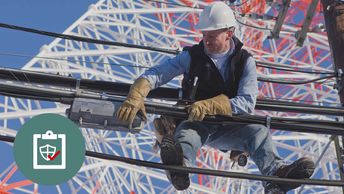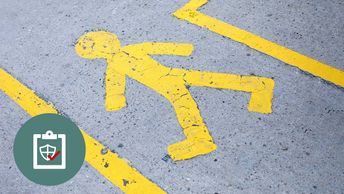Electrical Safety: Qualified Worker – Part 2
- 16 topics | 1h 31m 1s
- Up to 30 languages
- Transcripts
This course is the second part of a comprehensive overview of the basic criteria for electrical safety-related work practices stipulated in the National Fire Protection Association (NFPA) 70E Standard for Electrical Safety in the Workplace. It presents guidance on such topics as working near overhead or underground lines, using appropriate testing equipment for different environments, and selecting correct protective equipment in accordance with the NFPA Standard (2021 Edition). This course was developed with subject matter support provided by EnSafe Inc., a global professional services company focusing on engineering, environment, health and safety, and information technology. Please note, the course materials and content were current with the laws and regulations at the time of the last expert review. However, they may not reflect the most current legal developments. Nothing herein, or in the course materials, shall be construed as professional advice as to any particular situation with respect to compliance with legal statutes or requirements.
WHAT YOU WILL LEARN
-
identify approach distances for unqualified and qualified persons when working on or near overhead power lines
-
identify minimum clearances for vehicles and mechanical equipment when working near overhead power lines
-
identify the steps to establish electrically safe work conditions
-
identify approach distances, clearances, and how to establish electrically safe work conditions
-
identify the shock boundary in a scenario
-
recognize appropriate guidelines for working near exposed live parts
-
identify shock boundaries and recognize appropriate guidelines for working with live parts
-
recognize safe practices for the use of cord-and-plug equipment
-
select meter category ratings for a testing environment
-
recognize safe practices for cord-and-plug equipment and how to select appropriate test equipment
-
recognize general guidelines for the use of protective equipment
-
select PPE with the appropriate arc-rating given the electrical risk involved
-
recognize how select appropriate PPE
-
select the appropriate class of insulating equipment given a potential voltage exposure
-
recognize when insulating equipment should not be used on account of defects
-
select the appropriate class of insulating equipment and recognize the defects that would prevent its use
IN THIS COURSE
-
Electrical Safety: Qualified Worker – Part 21m
-
Working Near Overhead Lines7m
-
Working Near Underground Lines or Equipment6m
-
Knowledge Check: Working Near Underground Lines or Equipment6m
-
NFPA 70E Arc Flash and Shock Protection Boundaries6m
-
More Safe Practices Around Exposed Energized Parts5m
-
Knowledge Check: More Safe Practices Around Exposed Energized Parts4m
-
Electrical Equipment, Power, and Lighting Circuits6m
-
Test Instruments and Equipment7m
-
Knowledge Check: Test Instruments and Equipment5m
-
Use of Protective Equipment and Tools6m
-
Select Appropriate Protective Equipment6m
-
Knowledge Check: Select Appropriate Protective Equipment3m
-
Electrical Protective Equipment Testing9m
-
Inspecting Insulating Equipment for Defects6m
-
Knowledge Check: Inspecting Insulating Equipment for Defects4m
YOU MIGHT ALSO LIKE
COMPLIANCE-COURSE
Electrical Safety: Qualified Worker – Part 1
COMPLIANCE-COURSE
Pedestrian Safety 2.0
COMPLIANCE-COURSE
Compliance Brief: De-escalation Techniques


